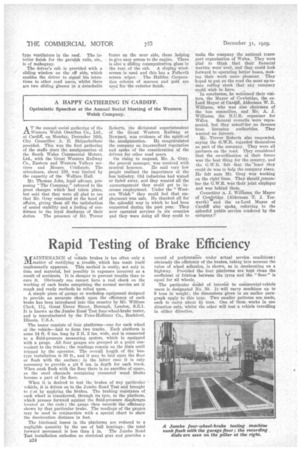Rapid Testing of Brake Efficiency
Page 58

If you've noticed an error in this article please click here to report it so we can fix it.
MAINTENANCE of vehicle brakes is too often only a matter of rectifying a trouble.. which has made itself unpleasantly apparent. This method is costly, not enly in time and material, but possibly in expenses incurred as a result of accidents. It is cheaper to prevent trouble than to cure it. Obviously one cannot have a real check on the working of each brake comprising the normal service set if rough and ready methods be relied upon.
A. simple piece of garage or workshop equipment designed to provide an accurate check upon the efficiency of each brake has been introduced into this country by Mr. William Clark, 11i, Great Dover Street, Borough, London, S.E.1. It is known as the Jumbo Road Test four-wheel-brake tester, and is manufactured by the Price-Hollister Co., Rockford, Illinois, U.S.A.
The tester consists of four platforms—one for each wheel of the vehicle—laid to form two tracks. Each platform is some 14 ft. 6 ins, long by 2 ft. 2 ins, wide, and is connected to a fluid-pressure measuring system, which is equipped with a gauge. All four gauges are grouped at a point convenient to the tracks ; the readings remain on the dials until tripped by the operator. The overall length of the bustype installation is 30 ft., and it may be laid upon the floor or flush with the surface ; in the latter case it is only necessary to provide a pit 6 ins, in depth for each track. When sunk flush with the floor there is no sacrifice of space, as the steel channels containing creosoted wood bloCks
become a part of the floor. .
When it is desired to test the brakes of any particular vehicle, it is driven on to the Jumbo Road Test and brought to nst by applying the brakes. The braking resistance of each wheel is transferred, through its tyre, to the platform, which presses forward against the fluid-pressure diaphragm located at the ends ; the gauge then records the efficiency shown by that particular brake. The readings of the gauges may be used in conjunction with a special chart to show the deceleration distance in feet.
The frictional losses in the platforms are reduced to a negligible quantity by the use of ball bearings ; the total forward movement is less than -k in. The Jumbo Road Test installation embodies no electrical gear and provides a B24 record of performance under actual service conditions; obviously the efficiency of the brakes, taking into account the value of wheel adhesion, is shown, as in decelerating on a highway. Provided the four platforms are kept clean the coefficient of frieticei between the tyres and the " floor " is equal for all wheels. The particular iiiO ' del interest to commercial-vehicle users is designated No. 30. It will carry machines up to 9 tons in weight ; the dimensions given in an earlier paragraph apply to this type. Two smaller patterns are made, each to carry about 4-i tons. One of them works in one direction only, whilst the other will test a vehicle travelling in either direction.




































































































